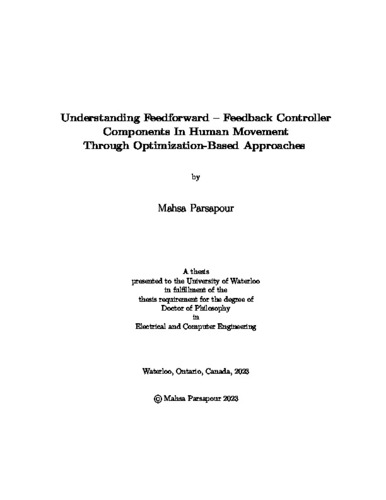| dc.contributor.author | Parsapour, Mahsa | |
| dc.date.accessioned | 2023-04-10 17:45:27 (GMT) | |
| dc.date.available | 2023-04-10 17:45:27 (GMT) | |
| dc.date.issued | 2023-04-10 | |
| dc.date.submitted | 2023-03-09 | |
| dc.identifier.uri | http://hdl.handle.net/10012/19263 | |
| dc.description.abstract | Despite many studies in human motion analysis using optimal control theory to understand how movement is generated, less attention is focused on the structure of the optimal controller. The majority of existing studies assume that the person is using a feedforward controller to accomplish the desired task. However, during perturbed motions a feedback controller becomes active, and enables the person to react to unforeseen perturbations and adapt their motions to the environment. As such, understanding controller structure becomes important to analyze human motion more accurately. Three key contributions will be elaborated in this thesis to enable analyzing the human feedforward and feedback controller components.
The first key contribution is the formulation of an inverse optimization problem for trajectories generated by feedforward-feedback controllers for nonlinear systems and feedback controllers for linear systems. We adapt the recovery matrix inverse optimal control approach, originally developed for recovering the cost matrices from trajectories observed under feedforward control, and apply it to analyze trajectories observed from systems controlled in the feedback form plus additional feedforward term. This method also estimates the feedback gain for linear systems where inverse linear quadratic regulator approaches are dependent on the given feedback gain assumption. The perturbation in this study is added as a zero mean Gaussian noise at the state output.
The second key contribution is an algorithm to decompose the controller components for tracking problems. This algorithm uses Bellman optimality condition to form an optimization problem to detect whether the system was disturbed or not. We formulate a constrained optimization problem to estimate the control signal. The identification of controller components is made based on the estimated and the reference experimental trajectories. The proposed approach is tested in simulation, where a perturbation is applied on different nonlinear systems in a continuous form.
The third key contribution is to combine the first two contributions to analyze feedforward and feedback controller components of human movement. First, squat motion is identified as a suitable motion for analyzing human perturbed motion and controller structure. We collected both unperturbed and perturbed squat motions for this study. The perturbation is applied during a short time in a continuous form through a push stick. Then the human body is modeled as a three degrees of freedom system, and the task is modeled by an optimal control problem. By modifying the decomposition algorithm, the trials are classified and the controller components are identified by the inverse optimal control. | en |
| dc.language.iso | en | en |
| dc.publisher | University of Waterloo | en |
| dc.title | Understanding Feedforward – Feedback Controller Components In Human Movement Through Optimization-Based Approaches | en |
| dc.type | Doctoral Thesis | en |
| dc.pending | false | |
| uws-etd.degree.department | Electrical and Computer Engineering | en |
| uws-etd.degree.discipline | Electrical and Computer Engineering | en |
| uws-etd.degree.grantor | University of Waterloo | en |
| uws-etd.degree | Doctor of Philosophy | en |
| uws-etd.embargo.terms | 0 | en |
| uws.contributor.advisor | Kulic, Dana | |
| uws.contributor.advisor | Mombaur, Katja | |
| uws.contributor.affiliation1 | Faculty of Engineering | en |
| uws.published.city | Waterloo | en |
| uws.published.country | Canada | en |
| uws.published.province | Ontario | en |
| uws.typeOfResource | Text | en |
| uws.peerReviewStatus | Unreviewed | en |
| uws.scholarLevel | Graduate | en |

